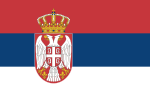Education in Serbia
 |
|
| Minister for Education, Science and Technological Development | Mladen Šarčević |
|---|---|
| Budget | 4.7% of GDP (2010) – 84th ranking of government expenditure on education worldwide. |
| Primary languages | Serbian |
| System type | nationalized |
| Total | 98% |
| Male | 99.3% |
| Female | 96.9% |
Education in Serbia is divided into preschool (predškolsko), primary school (osnovna škola), secondary school (srednja škola) and higher education (visoko obrazovanje) levels. It is regulated by the Ministry of Education and Science of Republic of Serbia.
The beginnings of education in Serbia date from 11th and 12th century with the establishment of schools at Roman Catholic monasteries in Titel and Bač in today's Vojvodina, which was then part of the Kingdom of Hungary. People were also educated in Serbian Orthodox monasteries like Sopoćani, Studenica and Patriarchate of Peć.
After the fall of medieval Serbian state, among newly established schools were Slavic and Latin schools. In 1778, Serbian primary school Norma was established in Sombor. In 1791, Gymnasium of Karlovci, the oldest Serbian gymnasium, was established.
During the First Serbian Uprising, Belgrade Higher School was established in 1808. In 1838, in Kragujevac, Liceum of Serbian Principality was established. It was moved to Belgrade in 1841. In 1863, it merged into the Belgrade Higher School. It had 3 faculties: philosophy, engineering and law. Later, it became the University of Belgrade.
University of Belgrade was established in 1905. After World War II, more universities were established, including University of Novi Sad (1960), University of Niš (1965), University of Pristina (1969), University of Montenegro (1974) and University of Kragujevac (1976). In 2006, the State University of Novi Pazar was established.
...
Wikipedia
